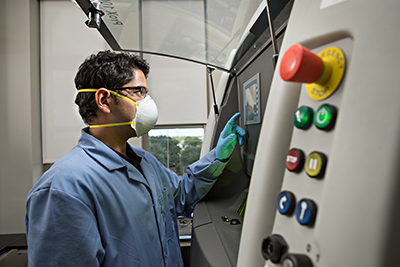 A team of researchers from the Department of Materials Science and Engineering and the Department of Industrial and Systems Engineering at Texas A&M University is collaborating to 4-D print nickel-titanium shape memory alloys.
A team of researchers from the Department of Materials Science and Engineering and the Department of Industrial and Systems Engineering at Texas A&M University is collaborating to 4-D print nickel-titanium shape memory alloys.
The research group is comprised of Dr. Ibrahim Karaman, department head and Chevron Professor I; Dr. Raymundo Arróyave, associate professor, materials science and engineering; Dr. Ji Ma, assistant research scientist, Texas A&M Engineering Experiment Station; and Dr. Alaa Elwany, assistant professor, industrial and systems engineering.
“Our goals are to achieve the ability to manufacture ‘smart’ monolithic metallic structures that will respond to stimuli over time and have a different location-dependent stimulus response within the same part,” Elwany said. “In our case, this is retaining their original shape upon being subjected to a temperature stimulus.”
The structures are considered “smart” because they can change their physical shape or properties on demand when a stimulus, such as a temperature change or magnetic field is applied.
“In this case, our material has a ‘remembered’ shape,” Ma said. “If you bend it out of shape, the material will go back to its original shape after being heated.”
While other work has been conducted in this area, the materials previously tested returned to the remembered shape after heating to one specific temperature. The team’s work now makes it possible for different parts of the same piece to return at different temperatures. This provides the ability to create devices that can assume multiple different shapes at different temperatures.
The team has also expanded on previous work by going beyond simple material shapes, such as wires, to more complex shapes due to the properties created from the various processing parameters used in the 3-D printing process. As a result of their research, this is the first time complex materials with multiple programmable shapes have been possible.
“The next step is to actually develop a framework for the design of shape and functionality and, from the design specification, determine the required materials and processing conditions,” Arróyave said. “This is a very, very hard problem that requires considerable development of new computational, experimental and statistical tools and we have the team to carry it out.”
“The team we put together to execute this challenging problem includes experts in shape memory alloys, materials processing, additive manufacturing, and computational materials and process design,” Karaman said. “By controlling the local properties of the structures and grading the functionality, we take the conventional 3-D printing processes converting them into ‘4-D printing’ technology.”
As a result of their work, in the space and aeronautics industry satellite solar panels will have the possibility of multiple stages of unfolding and deploying, instead of simply being on or off. In the medical industry, implants can have devices that deploy or change shape at different times or temperatures to allow more complex surgical insertions or placements. On smart locks or switches, more analog control is possible, such as a volume knob instead of a single on or off button.
The work was published in Scientific Reports, a Nature publication with an impact factor of 5.2. The original research publication can be found here.